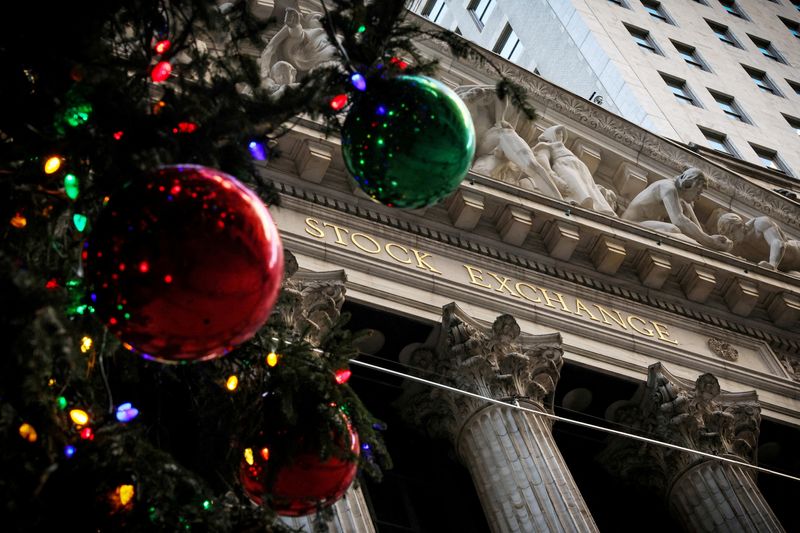By Lawrence Delevingne and Alun John
(Reuters) -Global shares pulled back on the last trading day of the year but notched their biggest annual rise since 2019, while U.S. Treasuries finished the year broadly where they started after major swings for the benchmark in 2023.
Shares around the world have risen sharply in the last two months of the year as benchmark bond yields fell on expectations of central bank rate cuts in 2024.
"In a slow holiday week, there was little to change the backdrop of resilient if slowing activity, underlying inflation still stuck around 3-4%, but a Fed that will be cutting rates regardless in 2024," Citi analysts wrote in a note Friday.
The S&P 500 fell about 0.3% on Friday, just shy of its record closing high reached on Jan. 3, 2022. The index finished up about 24% this year, thanks to a massive rally in megacap tech stocks. The Dow Jones Industrial Average and the Nasdaq Composite both dipped on Friday but were 13.7% and 43.4% higher for the year, respectively.
European shares ended 2023 with an annual gain of almost 13% on hopes of softer monetary policy from major central banks next year, while MSCI's world share index posted a 20% gain, its most in four years.
"We have eaten a lot of the returns that were expected in 2024. The positive momentum in markets is obviously associated with the fall in yields, and so now the question is, how long can this trend continue?" said Samy Chaar, chief economist at Lombard Odier.
Chaar said future returns "are probably more moderate" than they were at the beginning of November, but if long-term U.S. interest rates settle around 3.5% or 4%, there is "little danger of a big U-turn", and continued corporate profits might add "a few percent of upside".
The benchmark 10-year Treasury yield was at 3.866%, up 1.6 basis points on the day and right around its level at the start of the year.
That yearly performance masks some major swings, as the note's yield reached 5.021% in October, its highest since 2007, before retreating and driving the share rally.
Behind the move lower in yields has been a sustained decline in inflation around the world that has driven expectations that central banks will cut interest rates early next year. The U.S. economy has remained strong, feeding hopes for a "soft landing".
Markets are now expecting the U.S. Federal Reserve to start rate cuts in March, according to the CME FedWatch tool, a shift from assumptions just last month.
Traders are also pricing in more than 150 basis points of easing next year by the Fed, the European Central Bank and the Bank of England.
CHINESE UNDERPERFORMANCE
Chinese markets underperformed in 2023, despite optimism at the start of the year when Beijing ended its zero-COVID policy.
Both Hong Kong's Hang Seng Index and China's onshore blue chip index lost more than 10% in the year on waning investor confidence in the world's second largest economy. Those losses compare to Japan's Nikkei 225 Index, which gained 28% on the year. [.SS]
In the currency markets, the dollar ticked up on Friday but suffered a roughly 2% decline in 2023 after two years of strong gains, with declines mirroring the fall in U.S. yields. [FRX/]
In commodities, Chicago wheat and corn futures saw their biggest annual drop in a decade as easing supply bottlenecks in the Black Sea (NYSE:SE) region and higher production weighed on prices. [GRA/]
Oil prices were due to end 2023 down 10% after a year of wild swings driven by geopolitical concerns, production cuts and global measures to rein in inflation.

On Friday, U.S. crude fell 0.57% to $71.36 per barrel and Brent was at $77.08, down 0.09% on the day. [O/R]
Gold prices ticked down on Friday to $2,062 an ounce as they headed towards their best year since 2020, buoyed by hopes the U.S. Federal Reserve could cut interest rates as early as March. [GOL/]
